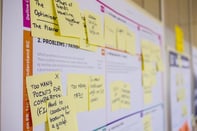Published on
Staying One Step Ahead of Higher Ed’s Consumers

It’s clear to see that higher education as gone through a whirlwind of change over the past couple of years—if not, decade. What’s become clear is that students are consumers and they know exactly what they want. This means institutions need to be paying close attention. In this interview, William (Bill) Bajor discusses the dramatic changes in higher education over the past decade, what consumers are now looking for from their institution and how higher ed leaders can leverage their Continuing Education units to meet new modern learner needs.
The EvoLLLution (Evo): What have been some of the most dramatic changes you’ve seen in the higher ed space over the past decade?
William (Bill) Bajor (WB): Higher ed consumers are more inquisitive than ever. They ask a greater volume of questions; and more significantly, they increasingly ask questions focused on the perceived value of their investment in terms of time, money, and overall benefit—personal and professional. It is important as an institution to be ready to answer those questions; for example, what your job placement rate is. While colleges and universities have career services offices, they really—by and large—do not have the personnel set-up to work on an individualized basis serving thousands of students (as well as alumni) to ensure that they get placed, retained…and really show evidence of success through economic self-sufficiency and financial security. In short, students want to know their ROI.
And that leads to the questioning of the educational product itself and its accompanying business model. I have observed higher levels of success with those Continuing Ed units empowered to make autonomous (not to be confused with siloed nor detached units from the school’s mission, vision and core values) decisions where business models are tailored and customized to particular products and services for distinct learner audiences in ways that a typical main campus organizational structure is simply not built for. We need to be able to adjust our business models to reflect what the students want and need. Taking that a step further; ideally, we would want to have such a pulse of the learner audiences we are serving that rather than design programming in reaction to what we are hearing from our students, we would be agile enough to have programming at the ready in anticipation of learner trends, as well as those trends of leaders in industry.
Evo: How challenging has it been to start adopting that mentality of higher ed as a business and how has it evolved over the past 10 years?
WB: I started full-time in higher ed in 2011, coming from the community-based sector after a number of years in community and economic development, including workforce development programming—which was industry driven and sector focused—in collaboration with a local community college. At the time, the word “customer” was already widely used as parlance to describe those participating as students in educational programming, especially under WIOA funded efforts. Higher ed soon followed suit, and began referring to students as customers and student experiences as customer experiences. What comes to mind as one challenge for many business offices in higher ed is distinguishing between the “customer” and “consumer”—especially when working with industry partners who pay the bill for employees or future employees to be trained. For example, if the college/university is an agreement with a school district, and the school district by contract or agreement is covering training costs, then the school district might be considered the customer, yet the student remains the consumer (i.e., the consumer of the educational product). In the traditional model where the student is responsible for covering tuition (or training) costs, the student is both the customer and consumer. I mention this because as colleges and universities increasingly look for new revenue streams, especially those driven by industry leaders, many need to gain a greater level of comfort and familiarity with different business models, including upgraded levels of service tailored to customers as well as consumers.
Going back to what we covered a bit earlier, more careful attention is required when it comes to effective student billing practices. There are more questions around the value of the educational product as well as the overall student experience. For example, if the student isn’t going to be on campus, then why are they paying student activities fees. These are the questions which increasingly come up time and time again. And if not addressed, they reflect a disconnect—which appears to exist at far too many schools—that continues to grow. You must be able to come to the realization of the disconnect, then address this disconnect, and really figure out where as an institution you wish to go. Which audiences are you prepared to serve effectively and genuinely?
Evo: What role can Continuing Professional Workforce Education units play in helping their respective institutions adapt to the evolving expectations of a modern learner demographic?
WB: It would seem that at many schools where CE has had success, CE units are really designed and well poised to be that sandbox to experiment, test new ideas and pilot new programming. Successful CE units are not afraid to learn by doing and learn through failure. For example, once an idea is tested, you go through a PDSA (Plan, Do, Study, Act) cycle, once it’s time to act you decide to adopt, adapt (and test again) or abandon the new idea you just tested. CE units appear to be much more ready for the agility required to stay in touch with the constant and rapidly evolving expectations of contemporary learners. CE Units are also frequently built to provide opportunities for alternate revenue streams. It’s in their nature, their very DNA, to not be shy to try something out and design a customized business model that might suit that particular project or initiative.
And should there be success; well, let’s see how scalable this is and where we can really take it. That’s tough for many institutions to do and even contemplate on the traditional academic side of the house. While which division (e.g., academic affairs, enrollment management, etc.) oversees CE units may vary from institution to institution, it’s important to allow them to be that sandbox; to be that free spirit, the most agile in terms of addressing critical socio-economic issues and community needs, like gaps between expected industry growth and shortfalls in trained regional talent at the ready. In terms of entrepreneurial business models supporting their work, successful CE units are comfortable with the notion of risk; with the full understanding that this in no way implies being careless and/or risky.
Evo: Do you see the capacity for CE units to innovate reducing in any way as they become strategically imperative to the institution itself?
WB: Without question. CE units—to be able to contribute to an institution’s overall sustainability and success rate most meaningfully—really need to be an integral part of an institution’s strategic plan. In addition to innovative programming in collaboration with academic affairs, it can also be through community engagement, alumni relations, economic development, etc. That speaks to the nimbleness and pliability of CE. With endless options and possibilities, it’s important for institutions to find a CE programming and business models that work for them. They have to be consistent with mission, vision and core values and be able to best maximize opportunities for success and meaningful impact for their students and their communities.
Evo: What are some dramatic impacts you’ve seen over the past decade?
WB: Especially with the pandemic, we’ve been forced to test the effectiveness of remote learning for entire portfolios; albeit on the fly—to an extent—and with loads of patience and improvisation. In the end, I believe we have all been hit with the unforeseen and it has made us more resilient. We have sharpened our reflexes. We’ve all been testing, trying new things out, in our sandboxes; and that’s exactly what CE does, and successful CE has been doing for decades. In doing this, we’ve all circled back to a renewed focus on the student experience. There used to be this notion that online learning and campus-based experiences were separate—but why can’t we have both? We’re adapting the way we see learning and being more engaged with learners and how they genuinely feel. Who says a so-called ‘traditional’ undergraduate student living on campus might not want an online course or two thrown into their schedule? The pigeon-holing of many student types and groups has been thrown on its head; and that’s a real positive after what everyone has gone through.
This is an opportunity to rethink the educational (not just higher ed) model across the board. This is a new moment of discovery. It’s interesting to see how we’re seeing more creativity with colleges, industry and community-based organizations coming together in terms of forging truly innovative partnerships. In the end, whether one’s focus is on incorporating new technologies, engaging industry leaders or grass roots community impact, having trusted people manage those relationships is critical. That’s another area where empowered CE units have had real meaningful success. They know their audiences and their partners; and they take the time to relentlessly nurture and grow those relationships.
Evo: Is there anything else you’d like to add?
WB: In terms of lifelong learning, like many others with a keen interest on this particular topic, the notion of the 60 YC resonates with me. I picture it like a rail pass—with unlimited miles—where people are empowered to forge their own unique lifetime journeys. It is also important to not lose sight of a ‘both’ mindset, as opposed to a ‘rather’ one when thinking about evolving models of education. It’s not about finding singular replacements and substituting one model for another, but about discovering varieties of new/different/alternate routes and additional pathways for those who simply may not follow a traditional educational and learning model as we have historically understood it. The impacts over the past decade indicate strong movements toward models focused on each student’s unique learning experience and each learner’s unique lifelong journey of continued growth and discovery.
This interview was edited for length and clarity.
Author Perspective: Administrator



